😉 Hello dear readers! The article “Diego Velazquez: biography, creativity, facts” – about the life of the artist and a description of several of his paintings.
Diego Rodriguez de Silva y Velazquez is a Spanish artist, the largest representative of the Madrid school during the golden age of Spanish painting. Court painter of King Philip IV. Among his students are Esteban Murillo and Juan de Pareja.
Velazquez: biography
Diego Velazquez was born in the summer of 1599 in Seville, Spain, in a family of emigrants from Portugal. Diego was the firstborn in the family, after him seven more children were born.
The boy’s talent was noticed by his parents since childhood. When he was 10 years old, he was sent to study with the artist Francisco Herrera. However, Diego stayed there for less than a year. Then the father assigned the teenager to Francisco Pacheco for as long as 6 years.
Pacheco was an educated man and admired the talent of the great Italian masters of the Renaissance. In addition, he was a painting censor at the city branch of the Inquisition. Here Diego mastered the drawing technique and found good friends in the person of the painter Alonso Cano and the painter Francisco de Zurbaran.
In 1618, 19-year-old Diego marries the 15-year-old daughter of his teacher, Juana Miranda.
First paintings
Velazquez’s first works were performed in the genre of bodegones, they depicted everyday scenes. At this stage of the young master’s creativity, one can feel the clear influence of caravaggism – emphasized realism in the image and contrasting lighting of the foreground.
It is worth noting that the plot depicted in the famous painting by the master “The seller of water from Seville” is also a kind of allegory. An elderly water carrier gives the young man a glass of water. At the bottom of the glass, you can see figs, which often serve as a symbol of eroticism.
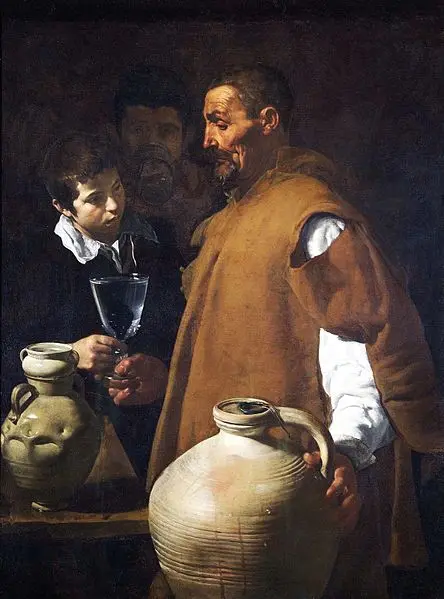
“Seller of water from Seville” 1619-1622. Wellington Museum, London
The artist traveled to Madrid to get acquainted with the masterpieces of painting in one of the royal palaces, Escorial. It was truly the richest collection, where paintings by Titian, Veronese were presented …
A visit to this gallery had a huge impact on the young painter. In his subsequent works, he shifts the emphasis to bright colors.
Court painter
Two months later, after returning to his homeland, Velazquez receives news of the death of the court painter Rodrigo de Viljandrando. He goes to the capital again.
When several works by Velazquez were presented to the prince, he orders him his portrait. However, Philip IV was already familiar with the image of the poet Luis de Gongor and decided to pose first.
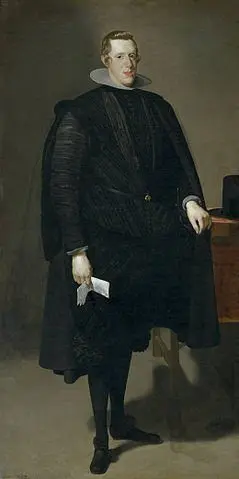
“Portrait of Philip IV with a petition” (c. 1623-1628). Prado, Madrid
The first painting, created by the master as a candidate for the position of the court painter, “Portrait of Philip IV with a petition”, was greeted with great enthusiasm. The king was still very young and only 6 years younger than Velazquez. He was fond of art and literature and even took painting lessons from H.B. Maino.
In the spring of 1627 Diego was appointed court painter. As a court painter, Velazquez painted portraits of Philip IV several times. Two portraits of the ruler are known: an equestrian (1634-35) and a canvas, created in 1655, representing an already mature, fifty-year-old king.
Among the creations of the great master who was able to reflect the subtlest color tones in his paintings. There was no shortage of images of women of the great dynasty.
The portraits of the second wife of Philip IV, Marianne of Austria, as well as the Infanta Margaret Theresa are a successful combination of subtle colorism with a composition full of scope.
On the canvases of the court artist, there could not be no royal children. Infant Balthazar Carlos proudly galloped on horseback or flaunted with a gun in his hands in the form of a young hunter.
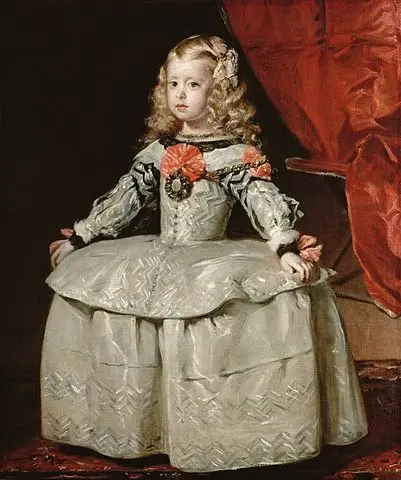
“Portrait of the Infanta Margaret in a White Dress”, 1656. Kunsthistorisches Museum, Vienna
Infante Felipe Prospero posed, leaning on a chair, in the company of a small dog. Infanta Margarita with a serious face at the age of three, another portrait when she was eight years old.
Italy
In the summer of 1629, the artist traveled to Italy to “improve his skills” and draw sketches of the Italian landscape.
In 1631, Diego Velazquez was commissioned to decorate the interior of the newly erected stately palace in Buen Retiro. The master also writes several canvases about the victories of Philip IV (“The Surrender of Delirium”). In 1642 – 44. he accompanies the monarch on a military campaign against Aragon.
In December 1648 the artist visited the Vatican. Innocent X ordered his portrait to him.
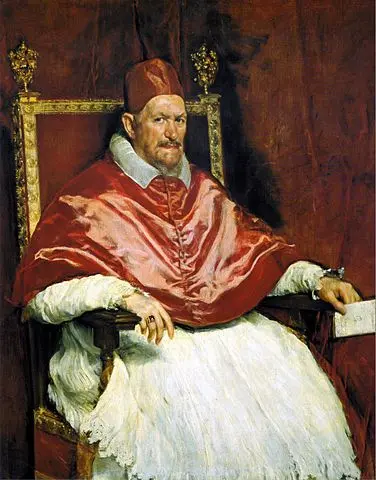
“Portrait of Pope Innocent X” 1650. Doria Pamphilj Gallery, Rome
Velazquez wrote this work for about three months. When it was presented, it literally stunned everyone. Dad, seeing him, could not restrain himself, exclaimed “Too true!” and awarded the author a medal, presenting him with a massive chain of gold.
Velazquez writes a work, unusual for Spain in those years, “Venus with a Mirror”. In the picture, a beautiful, but simple, earthly woman appears before us. Art critics hypothesize that Flaminia Trivio posed for the master.
There is also an opinion that there was a romance between the two artists. But Velazquez left for his homeland, and Flaminia gave birth to a son.
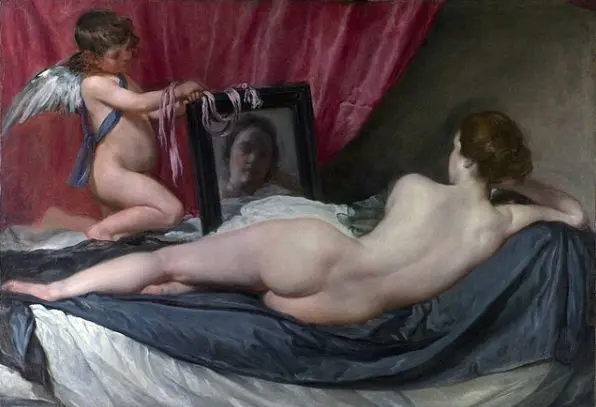
“Venus with a mirror” (1647-1651). London National Gallery
last years of life
In May 1651 Diego returned to Madrid. He creates paintings that are considered the pinnacle of his work – “Meninas” and “Spinners”. Four years before his death, Velazquez painted the famous painting “Meninas”. This work still admires and gives rise to various interpretations of the plot among novice painters.
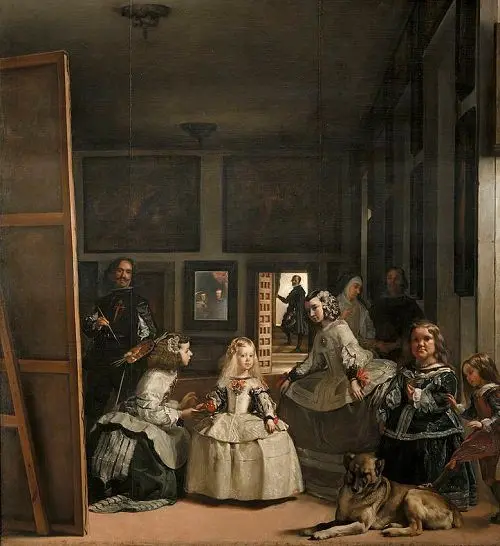
“Meninas” 1656. Prado, Madrid
In the picture we see the five-year-old Infanta Margaret-Teresa, daughter of Philip IV and his wife Marianne, surrounded by nobles. On the left side, with a palette and a brush in hand, is Velazquez himself.
In such portrait works, the persons in the painting are usually viewed from the point of view of the artist. Immediately, the master himself appeared on the canvas and looks at the royal couple. Her reflection is visible in the mirror at the back of the room.
In 1659 Velazquez was made a knight of the Order of Santiago. The master served for life as the court painter of Philip IV.
The artist took part in the wedding of Louis XIV and Philip IV’s daughter Maria Teresa. The celebration was held on a picturesque island located in the middle of the Bidasoa River in the summer of 1660.
When he returned home, he felt a fever. On August 6, 1660, Diego Velazquez passed away. With knightly honors, he was laid to rest in the church of St. John the Baptist. His faithful wife outlived her beloved husband by only 8 days and was buried next to her famous husband.
In 1811, the church was completely destroyed by the soldiers of Napoleon’s army. During his fifty-year career as a painter, Diego Velazquez created about 170 paintings.
Tip:
Unfortunately, in this short article there is no way to show all the paintings of the great master of painting. But there is a wonderful way out! Type on the Internet the request “List of paintings by Diego Velazquez”. You will see all the works of the artist in chronology, plus information on the topic “Diego Velazquez: biography and creativity”
😉 If you liked the article “Diego Velazquez: biography and creativity”, share with your friends in social. networks.









